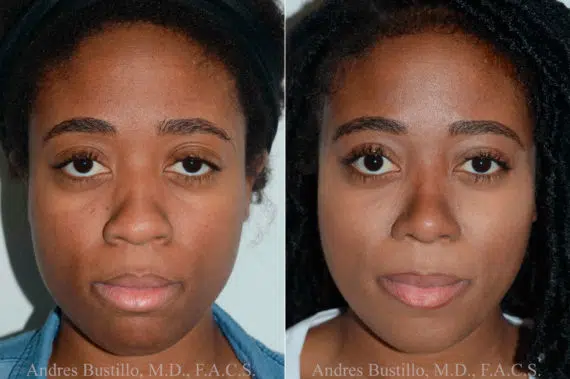Have you ever wondered if achieving the perfect nose is possible through modern cosmetic surgery? Many people feel self‑conscious about their nose shape, especially when dealing with a bulbous nasal tip. A rhinoplasty for bulbous nose can help refine facial features and improve tip definition, creating a natural balance that enhances overall beauty.
If you’ve been considering whether this surgery could transform your facial appearance, you’re not alone. With modern techniques, it’s possible to achieve a refined nose that complements your natural beauty. Read on to discover how experts address a bulbous tip and what to expect from the journey.

What is a Bulbous Nose Tip?
A bulbous nose tip is often described as having a rounded, enlarged, or wide nasal tip. Sometimes referred to as a fat nose, this condition creates a bulbous appearance that can affect the overall facial appearance. While not a medical issue, many individuals feel that a wide nasal tip detracts from their desired look and turn to rhinoplasty for a solution.
What Causes a Bulbous Nasal Tip?
Several factors can contribute to the development of a bulbous nasal tip. For many individuals, genetics play the largest role, as nasal shape and definition are often inherited traits passed down through family lines. This can influence the size and angle of the nasal cartilage, leading to a more rounded tip.
Another common factor involves the cartilage structure of the nose. In some people, the lower lateral cartilages are naturally larger or positioned in a way that creates excess width at the tip. This can exaggerate the rounded look and make the tip appear bulky.
Additionally, issues such as skin thickness or conditions like rhinophyma may also cause a bulbous tip. Thick nasal skin can conceal definition and exaggerate fullness, while rhinophyma, a rare skin condition, can create further enlargement. Together, these elements determine the overall look of the nasal tip and whether it develops a bulbous appearance.
How Does Bulbous Nose Surgery Work?
Refining a bulbous nasal tip requires a customized surgical procedure designed to reshape and redefine the tip. During this form of nasal surgery, the surgeon focuses on adjusting the underlying cartilage and soft tissue to achieve a balanced, natural look. Each technique is carefully chosen based on the patient’s anatomy and goals, ensuring results that harmonize with their overall facial structure.
Suturing Techniques
One of the most effective surgical techniques for refining a bulbous tip involves the careful placement of precision sutures. Through tiny incisions, the nasal tip cartilages can be narrowed and unified, bringing them closer together to create a more defined, elegant contour. This approach helps to reduce excess width while maintaining a natural appearance that complements the rest of the face.
Cartilage Grafting
When the nose requires added support or sharper definition, surgeons may rely on cartilage grafting. Small amounts of cartilage can be harvested from areas such as the septum or ear and placed strategically to reinforce the tip. This process strengthens the lower lateral cartilage and enhances the tip cartilages, creating a more stable and refined nasal framework. By carefully shaping and positioning these grafts, the surgeon ensures long-lasting improvements that look natural and proportionate to the patient’s features.
Addressing Thick Skin
For patients with thick nasal skin, refining the nose requires a careful approach. While the nasal tip skin itself cannot be removed, the underlying cartilage is reshaped to create a more defined structure. Over time, the skin gradually adjusts and settles over the new framework, allowing the improved contours to emerge. This technique ensures that patients with heavier skin still achieve noticeable refinement without compromising natural results.
Recovery from Bulbous Nose Rhinoplasty Surgery
The healing process after bulbous nose rhinoplasty is an important stage of your journey. During the first week, patients can expect some swelling and bruising, which gradually subsides as the days pass. Most people feel comfortable returning to normal daily activities within 7–10 days, although full refinement of the tip takes longer.
Successful rhinoplasty recovery depends on carefully following post-operative instructions. Patients are usually advised to keep the head elevated, avoid strenuous activities, and protect the nose from accidental bumps or pressure. Using cold compresses and taking prescribed medications can also help minimize swelling and discomfort.
Long-term results improve as the tissues settle and the new nasal definition becomes apparent. By attending follow-up visits, maintaining good overall health, and practicing patience, patients can ensure that their healing process leads to optimal outcomes and a nose that looks both natural and refined.
Questions about your procedure?
Schedule a consultation with Dr. Andres Bustillo.
Consult with an Expert Rhinoplasty Surgeon
Choosing an experienced facial plastic surgeon for your bulbous tip rhinoplasty is essential. Every nose is unique, and a tailored surgical approach ensures balanced results that harmonize with your nasal structure and overall facial proportions. The right expertise means achieving a refined nose with precision rather than an artificial look.
Dr. Andres Bustillo, a board-certified expert plastic surgeon, has over 20 years of experience in facial plastic surgery. Having trained at the prestigious NYU-Weill Cornell Fellowship Program, he brings artistry and technical mastery to every case. Recognized as a Top Doctor in Miami, Dr. Bustillo is dedicated to delivering natural results that highlight your beauty. Call us today at 305-663-3380 or visit our contact page to schedule your consultation.



